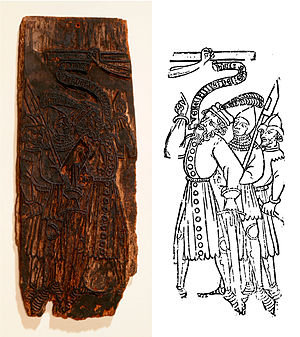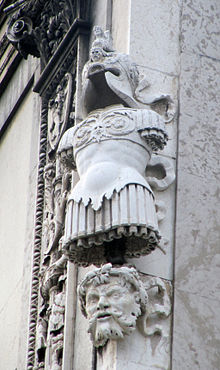Introduction

The visual arts are art forms such as painting, drawing, printmaking, sculpture, ceramics, photography, video, filmmaking, comics, design, crafts, and architecture. Many artistic disciplines, such as performing arts, conceptual art, and textile arts, also involve aspects of the visual arts as well as arts of other types. Also included within the visual arts are the applied arts, such as industrial design, graphic design, fashion design, interior design, and decorative art.
Current usage of the term "visual arts" includes fine art as well as applied or decorative arts and crafts, but this was not always the case. Before the Arts and Crafts Movement in Britain and elsewhere at the turn of the 20th century, the term 'artist' had for some centuries often been restricted to a person working in the fine arts (such as painting, sculpture, or printmaking) and not the decorative arts, crafts, or applied visual arts media. The distinction was emphasized by artists of the Arts and Crafts Movement, who valued vernacular art forms as much as high forms. Art schools made a distinction between the fine arts and the crafts, maintaining that a craftsperson could not be considered a practitioner of the arts. The increasing tendency to privilege painting, and to a lesser degree sculpture, above other arts has been a feature of Western art as well as East Asian art. In both regions, painting has been seen as relying to the highest degree on the imagination of the artist and being the furthest removed from manual labour – in Chinese painting, the most highly valued styles were those of "scholar-painting", at least in theory practiced by gentleman amateurs. The Western hierarchy of genres reflected similar attitudes. (Full article...)
Selected article

The woodblock fragment Bois Protat ([bwɑ pʁɔta] ("Protat wood[block]"); also Protat block or Protat woodblock, c. 1370–1380) is a fragmentary woodblock for printing, and the images on it are the oldest surviving woodcut images from the Western world. It is cut on both sides, with a scene from Christ's crucifixion on the recto, and a kneeling angel from a presumed Annunciation scene on the verso. The crucifixion scene likely consisted of three or more blocks; the surviving block fragment features Longinus the Roman centurion at the Crucifixion, shown speaking with a banderole, a mediaeval precursor to the modern speech balloon containing his words.
The Bois Protat's name comes from the Mâconnais printer Jules Protat who acquired the block after its discovery in 1898 near La Ferté Abbey in Saône-et-Loire, France, where it was wedged under a stone floor. Because of such poor preservation, only a quarter of the block has survived, and only one side was able to withstand making prints at the time of discovery. It is kept in the Department of Prints and Photographs at the Bibliothèque nationale de France, the National Library of France in Paris. (Full article...)Selected picture
Selected quote
| “ | I try to apply colors like words that shape poems, like notes that shape music. | ” |
| — Joan Miró, unknown |
Related portals
Selected biography
Gasparo Cairano, also known as Gasparo da Cairano, de Cayrano, da Milano, Coirano, and other variations (born Milan or Pieve del Cairo or Cairate, before 1489 – Brescia, died before 1517), was an Italian Renaissance sculptor.
The artist emerged in 1489 as part of the cultural world of Milan, beginning a successful career that turned him into a leading exponent of Renaissance sculpture in Brescia, distinguishing himself with works of cultural import such as his cycle of the Caesars for the Loggia palace in Brescia, as well as the Mausoleum of Martinengo. He introduced a powerful and highly expressive classical taste, as opposed to the hitherto existing refined decorativeness. During the first decade of the sixteenth century, Gasparo was able to win over public and private clients who sought to translate into stone their pride in their supposed historical descent from ancient Rome. (Full article...)Did you know (auto generated) -

- ... that André Delvaux was a magic-realist filmmaker who was made a baron by the king of Belgium?
- ... that a British filmmaker forced the British Board of Film Classification to watch paint drying for ten hours?
- ... that the art of Irma Blank, of "drawing languages without words" and including sounds, was recognised in the 1970s but fell into obscurity until a rediscovery in the 2010s?
- ... that the documentary Railway with a Heart of Gold has actual footage of a derailment captured whilst the filmmaker was attached to the side of the train?
- ... that entry to the British Royal Military Academy required the use of a drawing triangle with a completely different purpose from those used today?
- ... that Bernie Wrightson spent seven years drawing an illustrated edition of Mary Shelley's 1818 novel Frankenstein?
- ... that an Arkansas TV station apologized for not being on the air by sending local media a drawing of ducks?
- ... that Kip Andersen and Keegan Kuhn were co-nominees for the 2018 Cinema for Peace Award for their documentary What the Health?
General images
Major topics
- Types of visual art – Architecture • Art intervention • Ceramic art • Computer art • Drawing • Fashion • Film • Installation art • Land art • Mixed media • Painting • Performance art • Photography • Printmaking • Sculpture • Stained glass
- Art history – Pre-historic art • Ancient art • Art of Ancient Egypt • Art in Ancient Greece • Minoan pottery • Scythian art • Roman art • Women artists
- Western art periods and movements – Medieval art • Gothic art • Renaissance • Mannerism • Baroque • Rococo • Neoclassicism • Romanticism • Realism • Modern Art • Impressionism • Symbolism • Fauvism • Proto-Cubism • Cubism • Futurism • Dada • Art Deco • Surrealism • Abstract Expressionism • Lyrical abstraction • Conceptual Art • Contemporary Art • Postmodern art visual arts.
- Eastern and Middle Eastern art – Buddhist art • Chinese art • Islamic art • Japanese art • Laotian art • Thai art • Tibetan art
- Lists – Architects • Art movements • Art periods • Painters • Printmakers • Sculptors • Statues
- Lists of basic topics – Visual arts • Architecture • Film • Painting • Photography • Sculpture
Subcategories

Architecture | Ceramic art | Comics | Crafts | Design | Drawing | Illustration | Film | Glass | Graphic design | Industrial design | Landscape architecture | Multimedia | Painting | Photography | Pottery | Printmaking | Public art | Sculpture | Typography | Mosaic
Artists | Visual arts awards | Artist collectives | Art collectors | Art critics | Art curators | Visual arts exhibitions | Art forgery | Art history | Visual arts materials | Art schools | Artistic techniques |
WikiProjects
Things you can do
Associated Wikimedia
The following Wikimedia Foundation sister projects provide more on this subject:
-
 Commons
Commons
Free media repository -
 Wikibooks
Wikibooks
Free textbooks and manuals -
 Wikidata
Wikidata
Free knowledge base -
 Wikinews
Wikinews
Free-content news -
 Wikiquote
Wikiquote
Collection of quotations -
 Wikisource
Wikisource
Free-content library -
 Wikiversity
Wikiversity
Free learning tools -
 Wiktionary
Wiktionary
Dictionary and thesaurus







































































